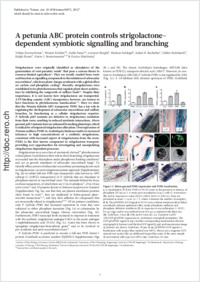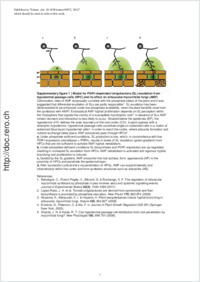A petunia ABC protein controls strigolactone-dependent symbiotic signalling and branching
- Kretzschmar, Tobias Institute of Plant Biology, University of Zurich, Switzerland
- Kohlen, Wouter Laboratory of Plant Physiology, Wageningen University, The Netherlands
- Sasse, Joelle Institute of Plant Biology, University of Zurich, Switzerland
- Borghi, Lorenzo Institute of Plant Biology, University of Zurich, Switzerland
- Schlegel, Markus Institute of Plant Biology, University of Zurich, Switzerland
- Bachelier, Julien B. Institute of Plant Biology, University of Zurich, Switzerland
- Reinhardt, Didier Department of Biology, University of Fribourg, Switzerland
- Bours, Ralph Laboratory of Plant Physiology, Wageningen University, The Netherlands
- Bouwmeester, Harro J. Laboratory of Plant Physiology, Wageningen University, The Netherlands - Centre for Biosystems Genomics, Wageningen, The Netherlands
- Martinoia, Enrico Institute of Plant Biology, University of Zurich, Switzerland
-
07.03.2012
Published in:
- Nature. - 2012, vol. 483, no. 7389, p. 341-344
English
Strigolactones were originally identified as stimulators of the germination of root-parasitic weeds that pose a serious threat to resource-limited agriculture. They are mostly exuded from roots and function as signalling compounds in the initiation of arbuscular mycorrhizae, which are plant–fungus symbionts with a global effect on carbon and phosphate cycling. Recently, strigolactones were established to be phytohormones that regulate plant shoot architecture by inhibiting the outgrowth of axillary buds. Despite their importance, it is not known how strigolactones are transported. ATP-binding cassette (ABC) transporters, however, are known to have functions in phytohormone translocation. Here we show that the Petunia hybrida ABC transporter PDR1 has a key role in regulating the development of arbuscular mycorrhizae and axillary branches, by functioning as a cellular strigolactone exporter. P. hybrida pdr1 mutants are defective in strigolactone exudation from their roots, resulting in reduced symbiotic interactions. Above ground, pdr1 mutants have an enhanced branching phenotype, which is indicative of impaired strigolactone allocation. Overexpression of Petunia axillaris PDR1 in Arabidopsis thaliana results in increased tolerance to high concentrations of a synthetic strigolactone, consistent with increased export of strigolactones from the roots. PDR1 is the first known component in strigolactone transport, providing new opportunities for investigating and manipulating strigolactone-dependent processes.
- Faculty
- Faculté des sciences et de médecine
- Department
- Département de Biologie
- Language
-
- English
- Classification
- Biological sciences
- License
-
License undefined
- Identifiers
-
- RERO DOC 28678
- DOI 10.1038/nature10873
- Persistent URL
- https://folia.unifr.ch/unifr/documents/302418
Other files
Statistics
Document views: 152
File downloads:
- pdf: 250
- Supplementary material: 123

